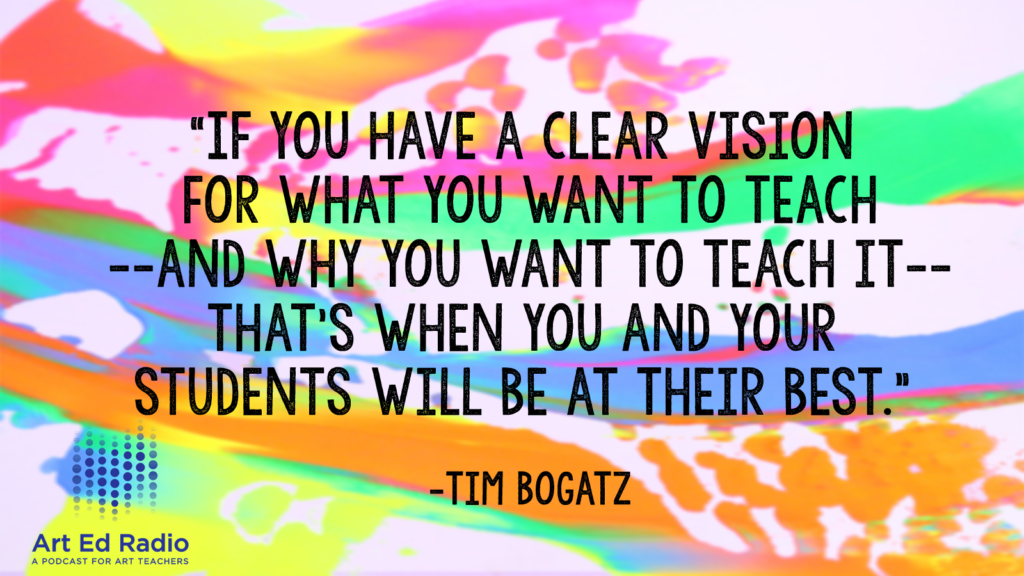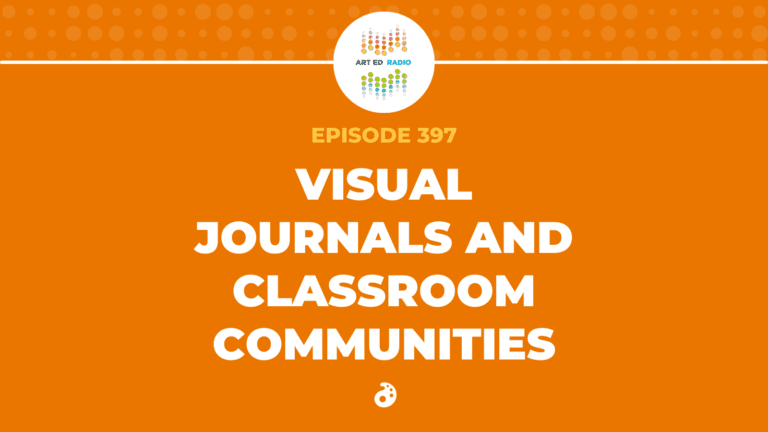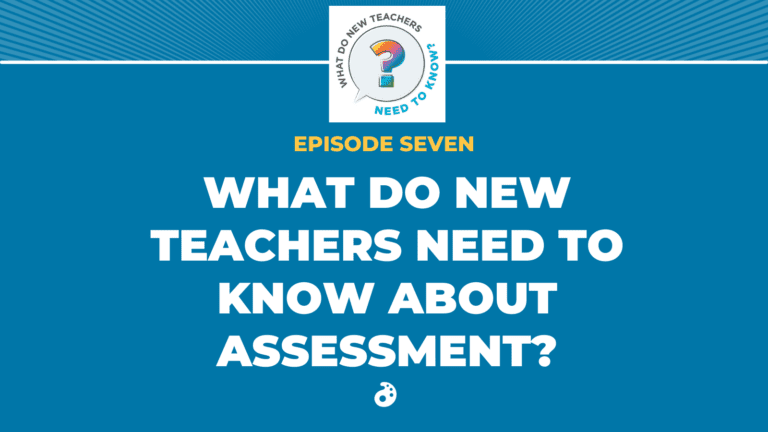As you get to the end of the year, it is a great time to reflect on what you are teaching and why. Tim and Andrew discuss how you can move past simple and baseline projects into more important work with your sutdents. They discuss why you can let perspective drawing fall by the wayside (4:30), differentiating between what needs to be a project and what needs to be a demo (12:00), and making work meaningful no matter the situation (20:30). Full episode transcript below.
Resources and Links:
- How to have more meaningful conversations with your students
- How to foster authentic art experiences
- 10 things to stop doing now as an art teacher
- Finally, here are 10 inspiring projects if you’re looking for something new

Transcript
Welcome to Art Ed Radio, the podcast for art teachers. This show is produced by The Art of Education and I’m your host, Tim Bogatz.
As we move toward the end of the year, I always find that I’m ready to reflect on what did and didn’t work over the last year. I also find that I get really excited about planning what’s going to happen in the upcoming year. You start thinking about all of the new and amazing things you want to try, the cool projects you want to do, incredible things that you want your students to experience. Now, Andrew and I have talked about how we rotate projects in and out like crazy, always trying new things, new idea, new projects. I know that’s not for everybody, but I do think it’s worth your time to think about what you are doing and more importantly, like much more importantly, it’s worth asking yourself why you are teaching the lessons that you do or the projects that you do. In fact, I think that’s a good litmus test for seeing if your projects need to stay in your curriculum.
When the question comes up about what students learn from a project or why you teach it, if you can’t answer why almost immediately, it might be time to move on. It might be time to find a better project to take its place. For me, I think a lot of these are your most basic projects. There seems to be this pervasive line of thinking the kids will never be able to draw realistically without doing 17 different 10-point value scales first or that they’ll never learn anything if they don’t memorize the elements and principles before all of their other art learning. Obviously, that’s a little bit of hyperbole on my part, but I think it really is a problem. Like, rote memorization and boring skill building and teaching drawing techniques that are just about the techniques, nothing more. Those things aren’t good. They aren’t good for your students, they definitely aren’t interesting for your students and I’m going to go out on a limb and say they probably aren’t that interesting for you when it’s time to present those ideas to your class.
I want you to have an open mind here as you listen to this discussion and give us a chance to convince you that there may be a thing or two that can be dropped from your curriculum and it can maybe even be dropped without causing irreparable harm to your student’s future in art. Let me bring on Andrew and we’ll talk about these seven projects that it’s okay for you to quit teaching.
All right, Andrew. Hello, how are you?
Andrew: Hey, man. I’m doing good. How are you doing?
Tim: I am doing really well. It is time for us to talk about the projects that it’s okay to abandon because I feel like we’re getting toward the end of the year. Are you feeling the drag of the end of the year right now?
Andrew: It’s kind of a drag, it’s more of just like, I would say it’s more of a squeeze. I’m feeling …
Tim: Okay.
Andrew: … I’ve got 12 days left. What do I still want to do? What do I have to get done?
Tim: Yeah.
Andrew: I have the really fun task of I’m moving buildings at the end of the year, so I have to …
Tim: Oh, man.
Andrew: Yeah, so school is out on Friday and Monday, the wrecking crew comes in.
Tim: Wow.
Andrew: I have to teach up until Friday, on June second, and then yeah. Whatever that Monday is, building’s locked and it’s a hard hat construction zone, so …
Tim: Wow.
Andrew: … I’ve got three days to pack up my mess of an art room.
Tim: I am not envious of you at all, but I will say this. I said in the intro, though, that now is the perfect time to kind of reflect on what you’ve done this year and start thinking about next year. What you want to change. I think it’s a really good time for us to discuss the projects that it’s okay to let go. The ones that it’s okay to quit teaching. I’m going to hit you up with my first idea for this one and see what you think. I really want to tell everybody out there that it’s okay for you to quit teaching perspective drawing. What do you think about that?
Andrew: Yeah, yeah. I think I might shock you here a little bit. People who are diehard fans of this podcast could probably guess or bet on which projects we’re going to make fun of and poke fun of and no, tie dye did not make the list, but perspective drawing is one that we both kind of maligned and said, you know, how important is it? It’s this thing that we always feel we’ve got to teach. I’ve never heard anyone, very few people, ever say they’re excited about teaching it, but okay, I’m going to shock you. I’ve been letting it for seven, eight years. I haven’t taught it in a long time.
Tim: Mm-hmm (affirmative).
Andrew: I’ve had so many kids this last year where I talked to them about drawing a cube and they are completely clueless. I show them a couple different strategies. I had one kid just flat out drop an F-bomb in front of me as I showed him how to make a three-dimensional cube. He said, “Shut the front door,” but he did not say shut the front door. I realize, man, maybe I need to start teaching perspective drawing again because some of my students were really, they were kind of clueless on it. I don’t know. I still don’t like teaching it and it is at the bottom of my list because here’s the thing. When was the last time I ever laid out a drawing and had like, here are my vanishing points, here’s my horizon? I don’t do that.
Tim: Yes, yes.
Andrew: I just draw from observation and I think that’s so much more important to teach.
Tim: Yeah, absolutely. The question I always ask myself is like what is the benefit of teaching perspective drawing? What do kids get out of it? For the amount of time that you put into, like, if you do one point perspective, and then two-point perspective, just think of how much time you’re putting into that. What’s the payoff? What do kids get out of it? Second part of that is I don’t know that it’s really worthwhile for them to come up with any perspective projects. What do you do for perspective that’s really exciting. You do your city scene, maybe you do your dream house in two-point perspective and, I swear to God, I’ve seen both of those projects a million times. I don’t see anybody really going beyond those ideas.
Then, third thing, and I’m ranting like you at this point, but I heard Ian Sands say this once upon a time. He was talking about how he learned perspective drawing in high school and then never dealt with it again until it was time for him to teach perspective drawing to high school kids. You really can go through an entire art career without ever using perspective and so I don’t see the point of dedicating weeks and weeks to it when it’s something that you can do, like you said, just one on one with your kids. Show them a little bit how it works, you know, give them the basics and that should be enough for them to go on. I don’t think you need to dive into amazing detail on this and spend just an inordinate amount of time on it.
Andrew: Yep, I totally agree and I think that quote from Ian, that’s a really great quote. I think for so many art teachers it rings true, but I want to switch things up because we’re really picking on those people who like the perspective drawings. I know there’s a couple people out there. I am guilty of this next one. We’re talking projects it’s okay to quit.
Tim: Yeah.
Andrew: I think I do a still life drawing, every ninth-grade art class, every year, and it’s always awful. My students always hate it. I always say to myself, “Why the heck am I doing this?” I think we’ve got to quit these just drab, still life drawings. We can let that go.
Tim: Yes, yeah. You know, those three questions that you ask yourself, like what a kid’s getting out of this, why am I teaching this? That’s a great sign that it’s okay to move on and so let me ask you this. Yes, there are some good skills that can be learned about how light hits objects, how reflections work, how shadows work and those are ideas that can transfer and yes, it can be worthwhile, but if kids are hating it, still probably not worth it. Anyway, let me ask you this. If you find a project that you are ready to quit teaching, do you A, abandon it completely, or B, try and sort of rethink it and come back with a better version or more exciting version?
Andrew: Yeah, totally the second one. I mean, before I send it off, because there had to have been some reason why you wanted to teach it in the first place or why you thought it was valuable. Right?
Tim: Yes.
Andrew: I mean, no one is, I think, hopefully if you’ve been teaching awhile, we’re not holding onto projects that we just absolutely hate. I mean, we always think that there’s something worth doing in there so before I totally lose all hope in it, I’ll try to really turn it upside down on its head or do something different or do it in a different order or a different material. See if I can get some better results out of it. You know?
Tim: Mm-hmm (affirmative).
Andrew: If I can’t get this baby to work on the second or third try, I mean, maybe it’s just got to go.
Tim: Yeah, I think that’s a good way to think about it so cool. All right. I’m ready to move on to number three here. The project that I really dislike teaching more than anything and one that my kids hate when we get into ceramics, is pinch pots. I think it’s okay to quit teaching pinch pots. It’s another one of those skills that can be taught really quickly and then maybe it will be used again, maybe it won’t, but you don’t need to spend a week and a half creating pinch pots and then suffer through the firing and the glazing with kids mumbling the whole time and moping around because they hate how it looks. They hate the whole process of creating pinch pots. Then, you end up with a bunch of wasted clay and a bunch of wasted glaze that is not exciting for anyone. There’s no good projects, kids don’t really learn that much, and so I’m ready to let pinch pots go. How are you feeling about that one?
Andrew: I like that one just a little bit more and again, I think people know that we’re all about context and you know your students better than anyone else. If it’s a skill that they are lacking, then by all means you should do it. Also, if you have a way to get it done quickly and painlessly, then maybe the payoff is worth it. I actually just recently this year, I didn’t really do a pinch pot project per se. Boy, say that three times fast.
Tim: Yeah.
Andrew: But, I did demonstrate how to take two very simple pinch pots, combine them into basically a giant sphere and then cut the lid off or piece of it off and have that serve as a lid because I had so many students just completely flummoxed on how to make sort of like some basic hollow shapes in ceramics. I did have to kind of say like this is going back to elementary school and I was teaching ninth graders at the time. Like, you just make a pinch pot, and so many kids were kind of like, what’s that? I was like, oh my gosh, okay. I had to show it to them and then show them how they could attach it, so I think if you’re going to … But, that was like a five-minute demo in the service of a bigger project.
I mean, I think that’s maybe one of the things. It’s like we might need to differentiate as teachers out there, what is a project and what is a demo? I mean, can you do a pinch pot demo in five minutes? Can you do a two-points perspective demo for five minutes that then serves a bigger, more powerful goal? Then, by all means, but no one’s excited about, hey it’s our pinch pot project. I mean, I don’t know. You really gotta jazz that up to sell it to your kids I think.
Tim: Yeah, and I think you’re hitting on a lot of good points. Like, if it’s something that can be taught in five or 10 minutes, teach it in five or 10 minutes. It doesn’t need to be a project on its own, but if you can show them that skill and then, like you said with the spheres, show them how it can be used in service of something bigger or something better, that’s the way it should be taught. I think that’s an idea to keep in mind as we go throughout all of these ideas here, but your turn. What do you got next for me?
Andrew: Well, I know there’s some people who are going to think I’m crazy, but I don’t think I’ve ever done a lesson plan on the color wheel.
Tim: Yeah.
Andrew: I think, again, it’s a good thing to know. It is a good poster to have in your room. I mean, if we look at it on its face value, it is just a theory and we could all have a different theory on what color combinations look good together, but to base a whole project on recreating a wheel in a fun and interesting way with the different color schemes, I mean …
Tim: Yeah.
Andrew: … that’s a hard sell to kids, too. I think so many art teachers are guilty of doing it right out the gate, first project of the year, first project of the semester, color wheel time. Oh boy, and I just think oftentimes I think it lands pretty flat.
Tim: Yep, just what I was going to say. I have taught color wheel projects repeatedly and I never, ever had a kid go, “Oh, that was awesome,” or “Oh, this is so exciting.” It is a drag and there’s so much better ways to learn that information. Just let your kids experiment with color. Let them try out their own things. Let them mix their own colors. Let them name their own colors. They don’t need to copy the circle of 12 and memorize the difference between secondary and tertiary. That stuff, in the grand scheme of things, not super important. If you’re going to art school, yeah, sure, it works, but for 99% of our kids, they’re not going to get a lot out of that and I agree with you. I’m good dropping the color wheel as well.
Andrew: Yeah.
Tim: I’m going to go back to clay again. As much as I hate pinch pots, I feel like I hate coil pots even more. Let me explain.
Andrew: Yeah, I was just going to say, man, I feel that we’re growing apart. I don’t know if I even know you anymore because you’re going to have to convince me. I kind of like coil pots. I think it depends on how kids kind of take it though.
Tim: Okay, so here’s my questions for you and they’re kind of rhetorical at this point. You don’t have to answer them, but number one. How long does it take you to teach a kid to make a coil? How long does it take you to show them to attach them? How long does any of that process really take? Then, once they’ve figured that out, do you really need them to spend weeks building a coil pot because it is a time-consuming process. Then, secondly, if you are going to spend weeks, what are you doing to make it a cool project? I mean, how you can alter it and maybe some of the coils go up and down and some of them go in spirals and things like that, but if you’re not moving beyond that, is that really worth three weeks of your semester? I’m not seeing it. I don’t know. Tell me why I’m wrong.
Andrew: Boy, I’m a push over. I actually think you’re right. I mean, so I have never really done a coil pot project for the sake of coil pots. I teach how to make, attach and, you know, taper in or flare out coils in the service of a bigger project. Usually, I do a face jug project where we look at the history of face jugs.
Tim: Yeah.
Andrew: Or, I’ll do like a monster mug or I’ll do a critter mug. Just kind of basic, like here’s how to make a jug or cup shape, but then the real payoff and the creativity is in the face and the sculpture on the outside. Yeah, the got it make it 12 inches tall and it has to have this direction and this direction, I think it’s a little formal for me. I’ve never been a huge fan of those.
Tim: Yeah, and I mean, they do have their time and place, I suppose, but I feel like we can do a lot better and just even the examples you mentioned right there, I think, are a good way to show how you can move beyond just the absolute basic ideas there. All right, you’re up next. What do you got for me?
Andrew: It’s been a while since I’ve even done this and it’s hard for me to even wrap my brain around these, so maybe you’ll explain where people come from when they do these, but any project that is just kind of like a nuts and bolts description of an element of art or a principle of design.
Tim: Yes, yes.
Andrew: Like, here’s an example of texture and it’s almost more like journal entries or poster. It’s almost like kind of scrap booking.
Tim: Yeah.
Andrew: I mean, the only thing I’ve ever done even close to that is sometimes I use the elements of art as like a prompt for ATC’s, but I tell them it has to be like a really abstract interpretation of these words. I don’t know. I guess I’m a little past the elements of art as like an end all, be all goal of what you’re teaching.
Tim: Yeah, same. I think, you know, this was actually going to be on my list before you just stole it from me, but I think my first year of teaching I was like, “Oh, my kids have to know the elements of art. Like, let’s make posters.” One kid’s like, line, here’s a definition of line. Here’s a drawing of a line. We spent like three days on that and my kids didn’t remember it afterwards. I’m like, what was the point of this? Yeah, I don’t think that, you know, we’ve talked about this before, but the elements and principles are generally not what you’re going to base most of your curriculum around. You can, but I feel like there are more exciting ways to do things and I feel like you can just turn on the elements and principles here and there and there’s no reason to stop everything or to not go on to something else until your kids have these things memorized. I don’t see how that serves students all that well, so I’m with you. I’m good on dropping anything that spends too much time defining the elements of art.
Andrew: Well, and I think that’s the problem with a lot of these. That’s the problem with the color wheel, that’s the problem with, you know, even perspective drawing. It’s like what are they teaching necessarily other than this sort of like abstract design art element? It’s like there’s got to be more to that to hold student’s attention. You know?
Tim: Yeah, absolutely, and I think you’re just operating at the most basic level when you’re teaching those things. I think it’s worthwhile to think about how you can move past that and move beyond that to see how those ideas can be used in other places and not just teach the ideas themselves, if that makes sense.
Andrew: Yep, cool.
Tim: All right, I know we need to get out of here, but one last one that I want to hit on. I am so tired of seeing Claude Monet’s Water Lilies being copied. Yes, it’s adorable, it’s cute, but I don’t need 30 of Van Gogh’s Starry Night sitting out there. I don’t need 30 of the same of anything or any art history copies because I feel like you’re just absolutely squashing kid’s creativity. You need to let them have their own take on things. Yeah, it’s awesome to look at artists. Yeah, it’s great to learn about art history. Yes, you can do some amazing things, but you don’t need to have them copying their work directly.
Andrew: Mm-hmm (affirmative). Well, I think that, that must have been something, a weird byproduct of discipline based art education back in the day.
Tim: Yes.
Andrew: I don’t think it was a deliberate thing. I think a lot of teachers maybe heard well one of the big tenets has to be art history. Oh, my gosh, we have to make our students look at master works and reinterpret it really similarly. I don’t know. I think there is a push now to get further and further away from that or have students look at master work, but then interpret it in a very unique personal and meaningful way. I totally hear you, man. I agree with you. I think the work’s got to be meaningful and I think it’s a balancing act, though. I mean, there’s some kids who like having that sort of recipe or formula for you do this, you do this, you do this. Presto, you’ve got a knock off. Whereas, if you let them have maybe too much freedom and they feel like they’re kind of floundering a little bit, and maybe this gets into the false divide of creativity versus like feeling competent and masterful, I don’t know. Here I go ranting again. I’m sorry.
Tim: No, no, I think you make some really good points. Those are some of the same things that I was going to say and so I think we’re very much on the same page there. Cool, all right, with that I think we’ll wrap it up, so Andrew, thank you very much for joining me. Yeah, it’s been a good discussion, so thanks.
Andrew: All right. Yep, thanks, man.
Tim: There you have it. The seven projects that it’s okay to quit teaching. Seriously, Andrew and I are giving you express permission to move on from those projects. If you want to keep teaching them, more power to you, but I think there are ways to move on from those simple baseline projects and get your students doing bigger and better things. Now that our discussion has destroyed your entire curriculum, it’s time to build a new one, which is why AOE’s Designing Your Curriculum course is the perfect graduate course for this summer. I say that part about destroying and rebuilding your curriculum facetiously, but in all seriousness, this is a great course if you’re looking for new and better ideas to improve your curriculum. You not only learn about the why when it comes to curriculum, but you learn and talk about the how. How to develop new ideas, engage your students and come up with amazing new projects that work together to enhance your curriculum and what you’re doing in the art room. There are new sections of the course beginning in June, July, and August. Go to TheArtOfEd.com/courses to check it out.
Anyway, as we wrap things up, I want to emphasize that Andrew and I are in no way criticizing you for teaching these projects. Every teacher does things differently and we absolutely understand that. In fact, you heard us disagree on some of the ideas just between the two of us. What we really want to do is help you reflect and help you think about why you are teaching what you teach. Like me, with perspective drawing, I kind of let it slide without really thinking about why I didn’t enjoy teaching on it, but after reflecting on the idea and listening to some other opinions, I was able to really clarify my thinking. I realized the way I was teaching it didn’t work for me personally and I wasn’t getting the outcomes I wanted for my students so I reset, found other ways and times to teach the concept, and I was so much happier with how that was presented into my classroom. I hope that this discussion is able to do that for you. Sometimes hearing some other opinions can help you with your own thinking and if you have a clear vision for what you want to teach and why you want to teach it, that’s when you and your students will be at your best.
Art Ed Radio was produced by The Art of Education with audio engineering from Michael Crocker. Remember that you can sign up for our email list at ArtEdRadio.com. Also, I want to remind you that you can always email Andrew and me at Radioguys@TheArtofEd.com. We love hearing your feedback, positive or negative, and it always helps us improve the show. Thank you for listening.
Magazine articles and podcasts are opinions of professional education contributors and do not necessarily represent the position of the Art of Education University (AOEU) or its academic offerings. Contributors use terms in the way they are most often talked about in the scope of their educational experiences.



